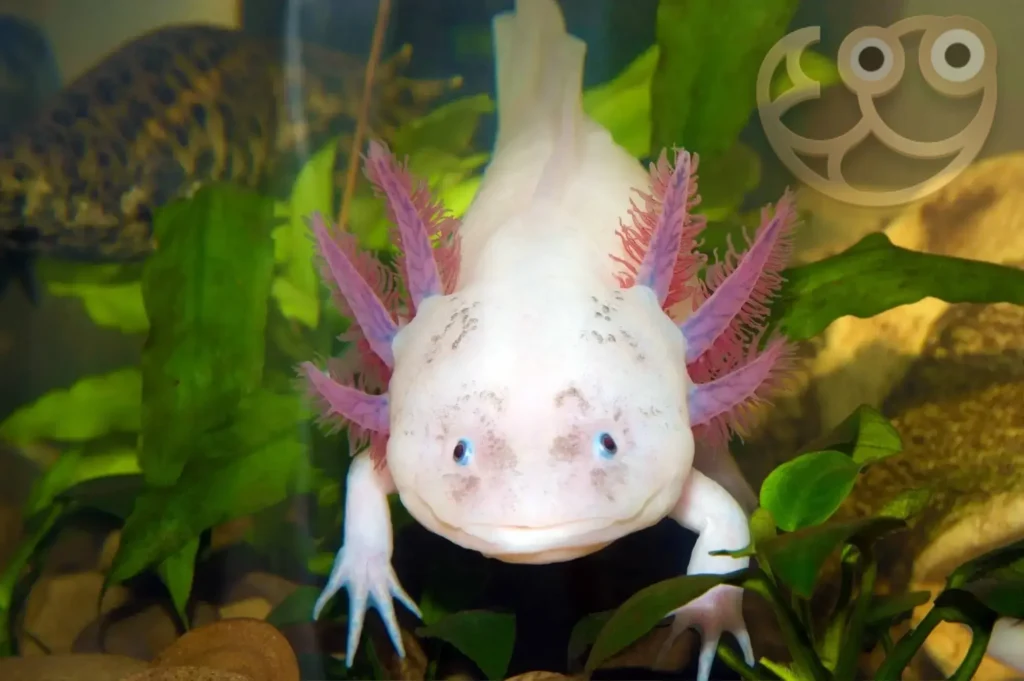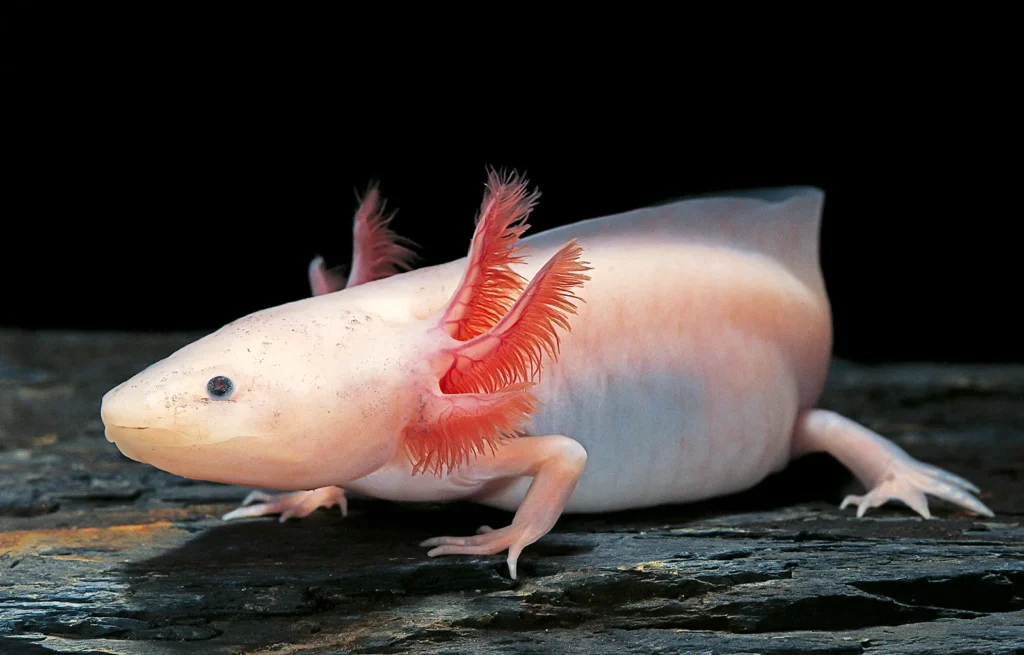The Axolotl (Ambystoma mexicanum) — The Forever-Larva and Regeneration Marvel
The axolotl is one of the most extraordinary amphibians on Earth. Native to the lakes surrounding Mexico City, this fascinating salamander has captivated scientists and nature lovers alike for centuries. What makes the axolotl truly remarkable is its ability to remain in its larval, aquatic form throughout its entire life — a biological phenomenon called neoteny — and its astonishing power to regenerate lost body parts, including limbs, heart tissue, spinal cord, and even parts of its brain.
The Science Behind Eternal Youth: Neoteny
Unlike most amphibians that undergo metamorphosis — transforming from gilled aquatic larvae into lung-breathing terrestrial adults — the axolotl retains its larval traits into adulthood. This means it keeps its external feathery gills and stays fully aquatic throughout its lifespan.
This trait is known as neoteny. Axolotls reach sexual maturity while still looking like larvae, meaning they can reproduce without ever leaving the water or losing their gills. This neotenic state is due to a lack of sufficient thyroid hormones that usually trigger metamorphosis in other salamanders.
In their natural habitat, this lifelong aquatic lifestyle may have evolved as an adaptation to their environment, which includes lakes with low iodine levels and variable oxygen content. Staying in the water and relying on gill respiration conserves energy and offers certain survival advantages.

Mind-Blowing Regeneration Abilities
Arguably the most famous feature of the axolotl is its unparalleled ability to regenerate complex body parts. If an axolotl loses a limb, it can regrow a fully functional replacement complete with bones, muscles, nerves, blood vessels, and skin — all without scarring.
But the axolotl’s regenerative powers don’t stop at limbs. It can also repair damaged parts of its:
- Spinal cord
- Heart tissue
- Lungs
- Jaws
- Eyes
- Brain tissue
This makes the axolotl an invaluable model for studying regeneration and healing in vertebrates.
Scientists have discovered that axolotl cells possess a kind of “positional memory.” When a limb is lost, cells at the injury site communicate to determine exactly what structures need rebuilding and in what order. Special molecules create gradients that guide this process so the new limb grows correctly.
For example, certain enzymes regulate the levels of retinoic acid—a vitamin A derivative—that acts like a GPS for regenerating tissues, ensuring proper pattern formation and growth direction. Genes such as Shox play a crucial role in orchestrating the growth of bones and cartilage during limb regrowth.
Life Cycle and Reproduction
Axolotls become sexually mature surprisingly early compared to their slow development in other ways. Typically, they can reproduce as early as 6 to 12 months of age, despite retaining their larval form.
The breeding ritual is quite elaborate: males and females engage in a “courtship dance” where the male deposits packets of sperm called spermatophores on the substrate, and the female picks these up to fertilize her eggs internally.
A single female can lay hundreds of eggs—anywhere from 100 up to over 1,000 at a time—which hatch in about two weeks. Hatchlings are fully independent from birth and must fend for themselves, finding food and shelter in the aquatic environment.
Physical Description and Behavior
Wild axolotls typically grow to lengths of 15 to 25 centimeters (6 to 10 inches) and weigh between 60 and 200 grams. They have broad, flat heads with wide mouths that often seem to be “smiling,” and lidless eyes that give them a perpetually curious expression.
Their most distinctive feature is the set of three pairs of external gills that fan out from behind their heads. These feathery gills allow them to extract oxygen directly from the water.
In their natural environment, axolotls are generally dark-colored—ranging from olive green to brown with mottled patterns that help camouflage them on the lake bottom. However, captive breeding has produced a variety of color morphs, including leucistic (pale pink with red eyes), albino, golden, and melanoid (all black).
Axolotls are carnivorous and primarily feed on small aquatic creatures like worms, insect larvae, and small fish. They hunt using suction feeding—opening their mouths rapidly to suck in prey.
Conservation Status: A Species on the Brink
Tragically, the axolotl is critically endangered in the wild. Its natural habitat in the lakes of Mexico City has been severely impacted by urban development, pollution, water diversion, and invasive species such as predatory fish.
Today, fewer than a thousand wild axolotls are believed to survive, mainly confined to remnants of their original habitat such as protected canals and small lake fragments. The degradation of their environment continues to threaten their survival.
Despite this, axolotls thrive in captivity worldwide, with large populations maintained in research labs, aquariums, and private collections. Captive breeding programs have become a vital part of efforts to prevent total extinction and have also facilitated scientific research on their extraordinary biology.
Conservation efforts focus on habitat restoration, pollution control, and reintroduction projects aimed at bringing captive-bred axolotls back into secure parts of their native lakes.
Why the Axolotl Matters
The axolotl is far more than just an odd-looking salamander. It represents a bridge between the ancient past and modern science. Its neotenic biology challenges traditional ideas about amphibian development, and its regenerative capabilities offer hope for breakthroughs in medicine, including regenerative therapies for humans.
Researchers continue to study axolotls to better understand how their cells can rebuild complex tissues without scarring—a feat that could one day inform treatments for spinal cord injuries, heart disease, and even brain damage.
Furthermore, the axolotl serves as an important reminder of the delicate balance between humans and nature. Its plight highlights how urbanization and environmental neglect can drive a species to the edge of extinction.

Quick Facts About the Axolotl
| Feature | Details |
|---|---|
| Scientific Name | Ambystoma mexicanum |
| Habitat | Freshwater lakes near Mexico City, Mexico |
| Unique Trait | Neoteny: retains larval form with external gills |
| Size | 15–25 cm (6–10 inches) |
| Regeneration | Limbs, spinal cord, heart, brain, and more |
| Reproductive Age | 6–12 months |
| Eggs per Clutch | 100 to over 1,000 |
| Conservation Status | Critically Endangered in the wild |
| Diet | Carnivorous: worms, insect larvae, small fish |
Final Thoughts
The axolotl is a symbol of scientific wonder and an emblem of biodiversity under threat. Its perpetual youth and regenerative prowess inspire researchers worldwide, while its endangered status calls for urgent conservation action.
Preserving the axolotl’s native habitat and supporting captive breeding and reintroduction efforts are critical steps to ensure this amazing amphibian continues to fascinate and educate future generations.
With its charming “smile,” feathery gills, and regenerative superpowers, the axolotl truly embodies the magic of the natural world.

